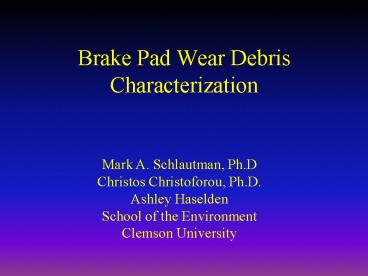Brake Pad Wear Debris Characterization - PowerPoint PPT Presentation
1 / 18
Title:
Brake Pad Wear Debris Characterization
Description:
... samples were run on a brake dynamometer to generate and collect BPWD following ... the various tests being conducted on surrounding dynamometers in the facility. ... – PowerPoint PPT presentation
Number of Views:263
Avg rating:3.0/5.0
Title: Brake Pad Wear Debris Characterization
1
Brake Pad Wear Debris Characterization
Mark A. Schlautman, Ph.D Christos Christoforou,
Ph.D. Ashley Haselden School of the
Environment Clemson University
2
BPP Technical Studies
Air Deposition Monitoring (SFEI)
Air Deposition Modeling (AER)
Representative Sample of Brake Pad Wear Debris
(BMC/Link Test Labs)
Physical Chemical Characterization of Wear
Debris (Clemson University)
Copper Source Loading Estimates (Process
Profiles)
Watershed Modeling(U.S. EPA)
Water Quality Monitoring (ACCWP)
Bay Modeling (URS)
Final Report Data Assessment Conclusions
Steering Committee, Scientific Advisory Team,
and Stakeholder Involvement Process (Sustainable
Conservation)
3
Generation of the Representative Brake Pad Sample
- PEC member companies provided information to the
BMC on the forms of copper used in OEM automobile
brake pads. - Pareto analysis of the data led to the selection
of three materials comprising greater than 90 of
the copper usage in OEM automobile brake pads. - PEC member companies prepared samples of their
brake pad formulations for use in generating
BPWD. - The proportion of each material in the
representative sample was based on the volume
sold on vehicles in 2002. - Three material samples were run on a brake
dynamometer to generate and collect BPWD
following the established protocol.
4
Characterization of Airborne BPWD Generated from
the Representative Sample
- Plan and methodology were presented at last
years Stakeholder meeting - MOUDI measurements on Materials A, B C
- Mass-based particle size distributions (PSD)
(gravimetric analysis) - Cu and Fe contents vs. size (digestion and
ICP-AES) - Calculate characteristics for theoretical
(composited) BPWD representative sample
5
MOUDI(micro-orifice uniform deposit impactor)
6
Airborne Characterization Results
7
Airborne Characterization Results
Replicate runs for three different brake pad
material formulations (note difference in scales)
8
Airborne Characterization Results
Material A 26.4 Calculated PSD for Material
B 14.1 ? Representative Sample Material C
59.5
9
Airborne Characterization Results
PSDs based on total mass, Cu, and Fe
10
Key Findings (Airborne Characterization)
- Generation of airborne BPWD was very different
for the three different materials. - Background levels of airborne particulate matter
in the testing facility much higher than
expected, and were variable on a day-to-day basis
(and perhaps over a much shorter time period).
The likely culprit for the high and variable
background concentrations was the various tests
being conducted on surrounding dynamometers in
the facility. - High background interference primarily affected
Material C results, but not the other two
materials.
11
Key Findings (Airborne Characterization)
- The mass mean aerodynamic diameter of the
airborne fraction of the composite BPWD material
was approximately 2.7 µm. - The total net average Cu and Fe contents of the
airborne fraction of the composite BPWD material
were 5.8 ( 0.4) and 15 ( 2),
respectively. - Cu content of the composite BPWD appeared to
decrease with increasing airborne particle size
above 0.075 ?m (trend was weak, and may not be
statistically-significant due to propagated
uncertainties). No trend was observed between Fe
content and airborne BPWD particle size.
12
Characterization of Non-Airborne BPWD Generated
from the Representative Sample
- Materials A, B C run back to back with no clean
out between materials - Cu and Fe contents (digestion and ICP-AES)
- Cu and Fe leaching using standard tests
(ICP-AES)
13
Non-Airborne Characterization Results
14
Non-Airborne Characterization Results
15
Non-Airborne Characterization Results
Comparison of final leaching solution pH values
for the two nonairborne BPWD samples
Comparison of leaching test results for the two
nonairborne BPWD samples
16
Key Findings (Non-Airborne Characterization)
- Cu and Fe contents in the nonairborne fraction of
the representative BPWD sample were 7.9 (? 0.2)
and 23.1 (? 1.2), respectively. - Both values were lower than previous nonairborne
BPWD sample, which had Cu and Fe contents of
10.8 (? 0.2) and 28.6 (? 0.4), respectively. - Both values were higher than the airborne
fraction of the representative BPWD sample, which
had Cu and Fe contents of 5.8 (? 0.4) and 15
(? 2), respectively. - Leaching of Cu from the nonairborne fraction of
the representative BPWD sample was high (60 to
100) in the more aggressive leaching solutions
but low (lt 5) in the less aggressive solutions. - Total Cu leaching potential similar to previous
nonairborne BPWD sample - Expected rate of Cu leaching lower than
previous sample
17
Limitations of Non-Airborne Sample
Characterization Results
- The leaching information is somewhat qualitative
and cannot be used as a direct input into the
watershed and bay models (e.g., serves as a
conceptual guide only) - Unanswered questions remain regarding the
partitioning of BPWD and Cu between airborne and
nonairborne fractions (may have implications for
copper loading estimates)
18
Questions ??
Thank you.































